This article needs additional citations for verification .(March 2016) |

The Planter's House Hotel was the name of three hotels in St. Louis, Missouri. The first operated from 1817, the second from 1841 to 1891, and the third until 1922.
This article needs additional citations for verification .(March 2016) |

The Planter's House Hotel was the name of three hotels in St. Louis, Missouri. The first operated from 1817, the second from 1841 to 1891, and the third until 1922.
There were three incarnations of the Planter's House hotel in St. Louis, Missouri. The first opened in 1817 on Second Street and was replaced with a larger hotel in 1841. [1] The first hotel was located on Second Street and was opened by Evarist Maury. Maury had intentions of expanding the hotel, but instead another Planter's House was erected on Fourth Street bounded by Chestnut and Pine. In 1836, a group of prominent St. Louisans gathered to discuss building the grandest and largest hotel in the city. Judge J.B.C. Lucas presided over the meeting, with Bernard Pratte serving as secretary. A committee was formed to find a site for the hotel and to determine shareholders. The committee included Messrs. McGunnegle, Morton, Kerr, and Brant. The site on Fourth Street, which was then owned by Judge Lucas, was decided to be the best location. On December 6, 1836, the shareholders met and elected directors for the company. The directors included Alexander R. Simpson, D.D. Page, D. Lamont, J.C. Laveille, E. Tracy, J. Charles, and G.W. Call. After applying to the Legislature in 1836-37, the company obtained a charter with capital of $1,000. Groundbreaking for the hotel occurred in March 1837, but work was not completed until 1841. [2]
Planter's House Hotel was four stories tall and had 300 rooms. [2] The hotel was decorated with rich carpets and paintings and the cutlery was made to order in England, with the hotels' initials engraved on each piece. Planter's Punch was invented at the hotel bar. The hotel also contained two dining rooms. [3] Planter's House was nearly called The Lucas House, after its patron Judge Lucas, but the proprietors decided to stick with the original name and the hotel began operations in April 1841. The hotel became a popular gathering place for politicians and businessmen. A room cost $4.25 per person and included four meals. [2] One of the lessees of the hotel, Benjamin Stickney, was a prominent St. Louisan and later served as director for St. Louis Gaslight Company, the Missouri Pacific Railroad, and the St. Louis National Bank. Stickney died on November 14, 1876. After his death, the hotel was reopened by J. Fogg & Co. [2]

The second incarnation of the Planter's House Hotel hosted many prominent guests. Some notable residents of the hotel were Jefferson Davis, Abraham Lincoln, Andrew Jackson, U.S. Grant, and William F. Cody. Charles Dickens also stayed at the hotel and wrote favorably about it. [2] Dickens devoted several pages of American Notes to St. Louis. He was impressed with many buildings in the city, including Planter's House, of which he wrote, "It is an excellent house, and the proprietors have most bountiful notions of providing the creature comforts." [4] In March 1847, Henry Clay visited St. Louis and stayed at the Planter's House. A soiree was also given there in his honor. [5]
A meeting that ultimately kept Missouri in the Union during the Civil War occurred at the Planter's House Hotel on June 11, 1861. Gov. Claiborne Jackson and Gen. Sterling Price, representing secession, met with Col. Nathaniel Lyon and Frank Blair. Lyon rejected a proposal to partition the state, resulting in a series of battles in Missouri at Boonville, Lexington, Carthage, and finally Wilson Creek, near Springfield. [6] Governor Benjamin Gratz Brown stayed there on May 3, 1871 (see image of hotel bill).
In 1882, the Planter's House's proprietors were listed as J&J Gerardi and the assessed value of the property was $15,440. [5]
The second hotel was damaged by fire in 1887 and torn down in 1891.
A new, grander, Planter's House Hotel was to be built to replace the fire-damaged building. Financing for the hotel was made possible when St. Louis was passed over to host the Columbian Exposition. Civic leaders in St. Louis had secured pledges of five million dollars, plus one million for entertainment at the fair. After the city lost the bid for the fair, the group offered a one-million-dollar bonus to the organization or individual who would build a first-class, fireproof hotel in St. Louis. Investors in the project chose a site at Fourth and Pine Street and hired Isaac Taylor to design the hotel. The new Planter's House Hotel had 400 rooms, an elegant main restaurant, a ladies' dining room, and various meeting and banquet rooms. Planter's Punch was invented at a previous incarnation of the hotel and at the third hotel bar, the Tom Collins was created by bartender Charles Dietrich. The lime, lemon, and gin drink was named after a regular and favored customer. The third Planter's House Hotel closed in 1922 and was later converted to an office building. [2] The third hotel was the last, and was demolished in 1976 and replaced with Boatmen's Tower, which later became the Bank of America Building. [1]

Normandy is a city in St. Louis County, Missouri, United States. The population was 4,287 at the 2020 census.

Frederick William Lehmann was an American lawyer, politician, United States Solicitor General, and rare book collector.

Tremont House, sometimes called the Tremont Hotel, was a hotel designed in 1829 by Isaiah Rogers in Boston, Massachusetts. Notable guests included Davy Crockett and Charles Dickens.
The culture of St. Louis, Missouri includes a variety of attractions located within the city of St. Louis, Missouri, and in surrounding communities in Greater St. Louis, such as local museums, attractions, music, performing arts venues, and places of worship.

The Astor House was a luxury hotel in New York City. Located on the corner of Broadway and Vesey Street in what is now the Civic Center and Tribeca neighborhoods of Lower Manhattan, it opened in 1836 and soon became the best-known hotel in America. Part of it was demolished in 1913; the rest was demolished in 1926.
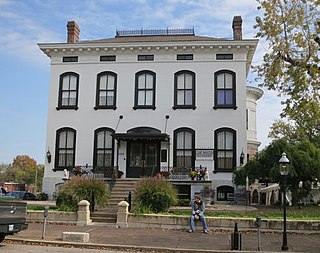
The Lemp Mansion is a historical house in Benton Park, St. Louis, Missouri. It is also the site of three suicides by Lemp family members after the death of the son Frederick Lemp, whose William J. Lemp Brewing Co. dominated the St. Louis beer market before Prohibition with its Falstaff beer brand. The mansion is said to be haunted by members of the Lemp family.
The Tremont House was a hotel located in Chicago, Illinois. A modern hotel also bears a similar name.

Robert Campbell was an Irish immigrant who became an American frontiersman, fur trader and businessman. His St. Louis home is now preserved as a museum: the Campbell House Museum.

The Battle House Renaissance Mobile Hotel & Spa, is a historic hotel in Mobile, Alabama. The current structure was built in 1908 as the Battle House Hotel. It is the second hotel by that name to stand in this location, replacing an earlier Battle House built in 1852, which burned down in 1905. It is one of the earliest steel frame structures in Alabama.
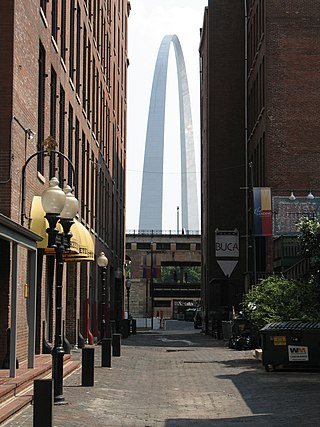
The architecture of St. Louis exhibits a variety of commercial, residential, and monumental architecture. St. Louis, Missouri is known for the Gateway Arch, the tallest monument constructed in the United States. Architectural influences reflected in the area include French Colonial, German, early American, European influenced, French Second Empire, Victorian, and modern architectural styles.

Barnett, Haynes & Barnett was a prominent architectural firm based in St. Louis, Missouri. Their credits include many familiar St. Louis landmarks, especially a number related to the local Catholic church. Their best-known building is probably the Cathedral Basilica of St. Louis. A number of the firm's works are listed on the U.S. National Register of Historic Places.

The Kansas City Club, founded in 1882 and located in the Library District of Downtown Kansas City, Missouri, USA, was the oldest gentlemen's club in Missouri. The club began admitting women members in 1975. Along with the River Club on nearby Quality Hill, it was one of two surviving private city clubs on the Missouri side of Kansas City. Notable members include Presidents Harry Truman and Dwight D. Eisenhower, General Omar Bradley, and political boss Tom Pendergast. It closed in 2015.

George Ingham Barnett (1815–1898) was an architect from St. Louis, Missouri. He was called "The Dean of St. Louis Architecture" for his contributions to the buildings of St. Louis as well as for his influence on other architects in the United States.

The history of St. Louis, Missouri from 1804 to 1865 included the creation of St. Louis as the territorial capital of the Louisiana Territory, a brief period of growth until the Panic of 1819 and subsequent depression, rapid diversification of industry after the introduction of the steamboat and the return of prosperity, and rising tensions about the issues of immigration and slavery. St. Louis also played a role in the American Civil War.

The lynching of Francis McIntosh was the killing of a free Black man, a boatman, by a white mob after he was arrested in St. Louis, Missouri, on April 28, 1836. He had fatally stabbed one policeman and injured a second.
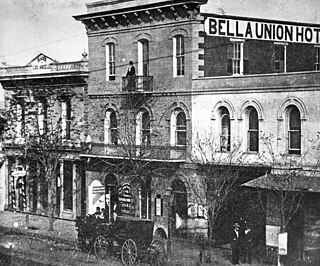
The Bella Union Hotel in Los Angeles, California, constructed in 1835, is California Historical Landmark No. 656. It was effectively the last capitol building of Mexican California under Governor Pio Pico, in 1845–47, and was a center of social and political life for decades. The hotel was located at N. Main Street, on the east side, a few doors north of Commercial Street, which then ran east–west between Arcadia and Temple. The hotel was later known as the Clarendon and then as the St. Charles.
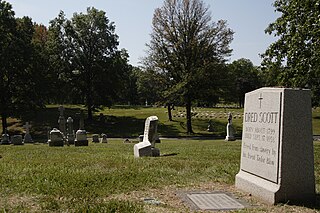
Calvary Cemetery is a Roman Catholic cemetery located in St. Louis, Missouri and operated by the Archdiocese of St. Louis. Founded in 1854, it is the second oldest cemetery in the Archdiocese. Calvary Cemetery contains 470 acres (1.9 km2) of land and more than 300,000 graves, including those of General William Tecumseh Sherman, Dred Scott, Tennessee Williams, Kate Chopin, Louis Chauvin and Auguste Chouteau.

Isaac "Ike" Stacker Taylor was an American architect. He was one of the most important architects in St. Louis and the midwestern United States at the turn of the twentieth century, designing commercial, residential, industrial, and governmental structures.
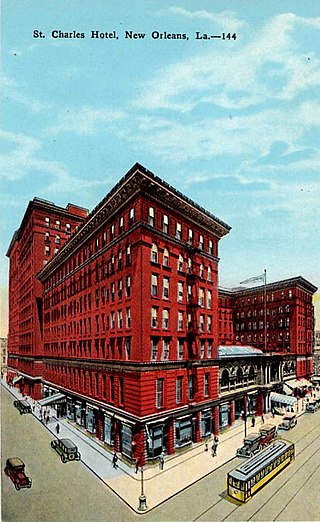
The St. Charles Hotel was a hotel on St. Charles Avenue in New Orleans, Louisiana. One of the first of the great hotels of the United States, the original Grecian palace-style building, opened in 1837, has been described by author Richard Campanella as "one of the most splendid structures in the nation and a landmark of the New Orleans skyline". It was some time before it found a rival in the Astor House, of New York City. It was said that the hotel's Parlor P had probably witnessed more important political events than any room or any building in the country, outside of the Capitol at Washington, D.C. During the Civil War, Union General Benjamin Butler seized the hotel to use for his headquarters after the city surrendered. The third incarnation of the hotel was finally demolished in 1974.